Why do strawberry leaves turn red, red spots appear on them: what to do, how to treat
As a rule, the first sign by which we determine that something is wrong with a plant is a change in the shape and color of its leaves. Naturally, strawberries are no exception. Indeed, the analysis of strawberry leaves allows you to assess the nutritional status of the plants (for example, lack of any element), the presence of diseases, as well as the stage of vegetation.
Well, then let's talk about why strawberry leaves turn red, because of what red-brown spots may appear on them, what to do in this case, how to help the plant, how to feed or process it.
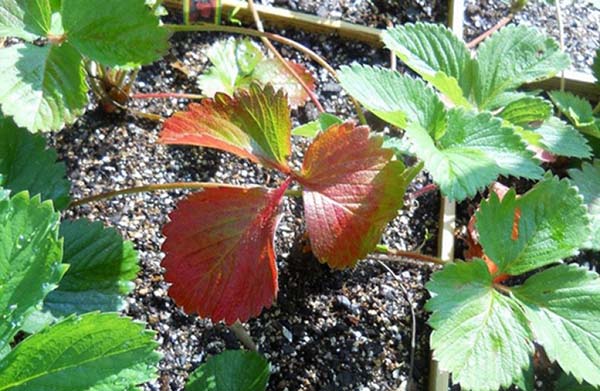
Content
Causes of reddening of strawberry leaves
So, garden strawberries can blush due to 3 blocks of reasons:
- fungal disease (white or brown spot);
- lack of nutrition (usually nitrogen, but there are other types of "starvation");
- natural withering away of old foliage.
Next, we will analyze each reason separately.
Addition! According to some gardeners, sometimes strawberry leaves start to turn red due to temperature differences in the second half of summer, which is quite natural, and also due to increased soil acidity (therefore, more often use for feeding wood ash, which will lower it!).
Fungal disease (red spots on strawberry leaves)
In case your strawberry bushes are struck by any fungal disease, then you will find exactly red spots on the strawberry leaves.
White and brown spotted strawberries
So if your strawberry bushes have picked up white spot (septoria), then:
- at first you will notice small (about 2-3 mm in diameter) rounded reddish brown spots on the leaves (while they will without border),
- then these spots become gray and white and acquire a dark red border (rim),
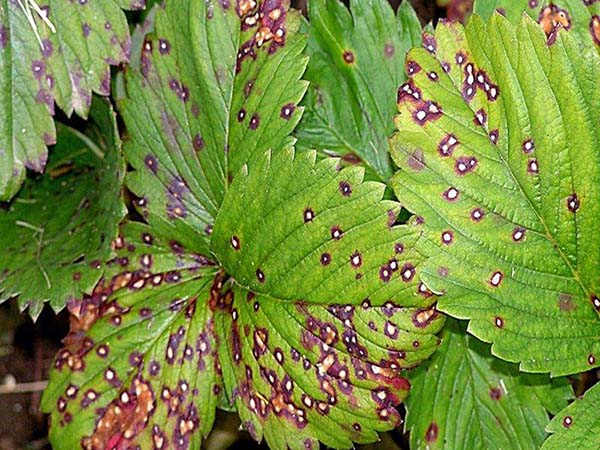
- Further the spots will completely turn white and fall out (this is the main specific difference of this disease).
- When severe infection part of the leaf dries up or the whole sheet dies off completely.
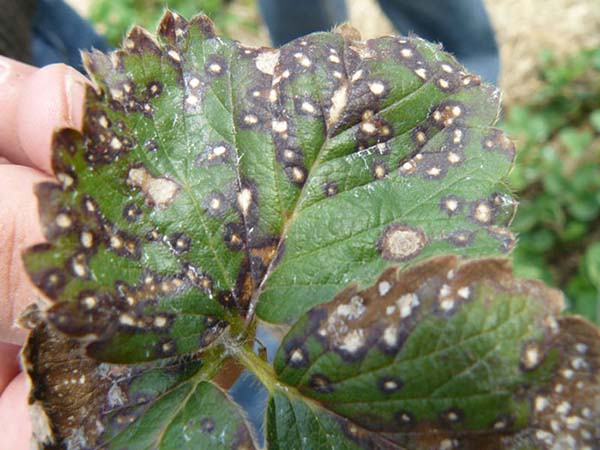
By the way! Also the disease affects petioles, antennae and peduncles... At the same time, on the petioles and antennae, it manifests itself in the form of longitudinally elongated brown spots, while the peduncles acquire not only a brownish color, but also become thinner and lie down.
Fruit also suffer, but do not rot, they only form hard dark brown spots, which significantly reduce the quality of the crop.
Peak development this fungal disease accounts for for the fruiting period (i.e. May-June).
What to do if strawberries get sick with white leaf spot?
- Promptly remove and burn (take out from the site) amazed spotted leaves.
- Spend preventive and eradicating spraying with fungicides (agents against diseases) in spring (when new leaves are just beginning to grow, i.e. even before flowering) and at the end of summer-autumn (after harvest).
For example, you can spray 1-% solution bordeaux liquid or 2-% solution copper sulfate, a special copper-containing preparation - Azophos (this is not only a fungicide, but also a nitrogen-phosphorus fertilizer), use Topaz... Alternatively, for the prevention of fungal diseases, it is suitable Fitosporin, Trichodermin or Guapsin (all biological fungicides).
- To not allow excessive thickening of landings (planting bushes should good ventilation, especially after rain or watering), including regularly and ruthlessly deleting weed plants (blind man's buff, oak tree, bakhmutka, pendant).
- In a timely manner remove old and dead leaves, in other words, conduct spring and / or autumn (after harvest) strawberry pruning.
The fact is that fungi remain on plant debris.
- Grow disease resistant varieties.
Note! Relative stability the following varieties possess white and brown spots: Talisman, Scarlet Dawn, Early Makheraukha, Generous, Sudarushka, Divnaya and Tsarskoselskaya. A little more susceptible Zarya, Beauty and Zenga Gigan.
Brown leaf spot
In case the strawberry has caught brown spot, on its old leaves, in the second half of the growing season, you will notice vague reddish-brown spots irregular shape with black dots in the center and dry edges, in other words, the affected leaves lookdying.
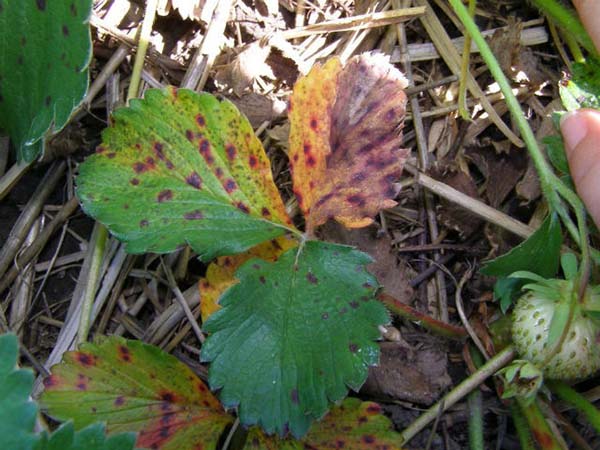
As in the case of white spot, the disease is especially pronounced with excessive thickening of the plantings, concomitant high humidity and frequent abundant watering, and the fungi themselves overwinter on dead and green leaves. Respectively, protective and preventive measures against brown spot will be similar to measures against white spot.
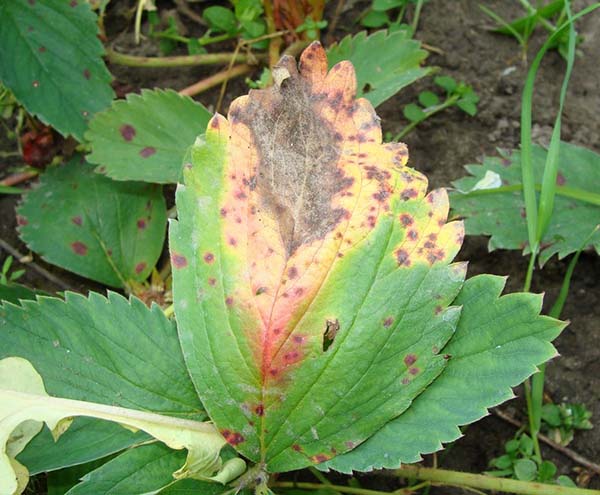
Video: how to deal with strawberry spotting
Lack of nutrition (red, purple leaves)
Another reason for the reddening of strawberry leaves, and in this case, it is not a small part (for example, in the form of a spot) that turns red, but the whole leaf or a large part of it, is the lack of a certain nutrient in the soil.
By the way! The site has a separate article about how to properly feed strawberries in spring and summer .
Color change in the case of "starvation" occurs due to the destruction of chlorophyll in the tissues of the leaf.
Important! The lack of a certain nutrient can be caused not only by its absence in the soil, but also by the lack of another element, thanks to which the first is absorbed. So, lack of nitrogen most often occurs due to phosphorus deficiency in the soil, and lack of iron manifests itself, for example, in the case excess calcium in the soil.
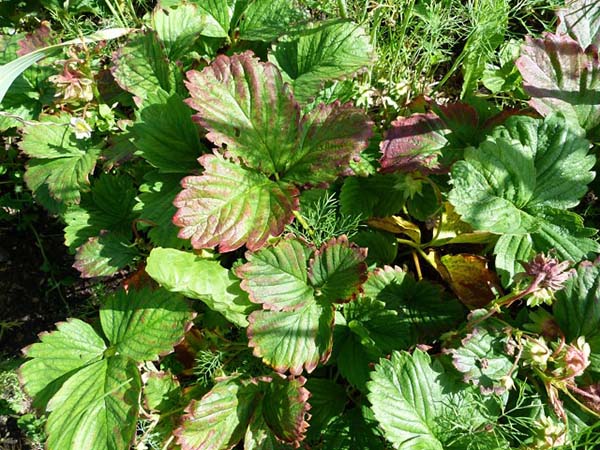
By the way! First of all, they acquire a red tint. old leaves of garden strawberries... The fact is that with a lack of the same nitrogen, phosphorus, potassium and magnesium in the soil, everything accumulated in the plant nutrition from old leaves is transferred to young.
But other elements, such as iron, are not capable of being recycled (reused), i.e. food is not transferred from old to young leaves, which means that signs of deficiency will appear on younger leaves.
Nitrogen
If strawberry leaves started to blush in summer, then this clearly indicates a lack of nitrogen.
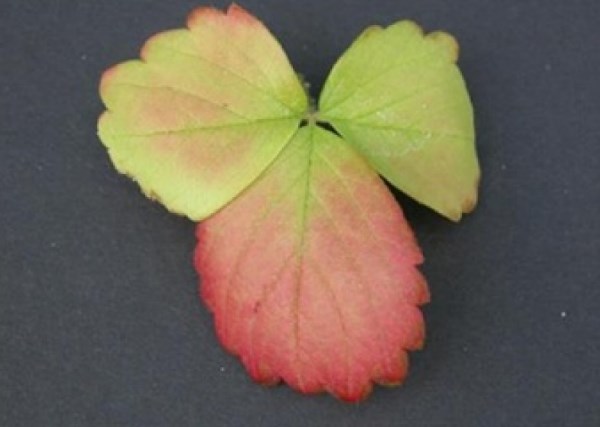
And in this case leaves blush not in parts, but in whole.
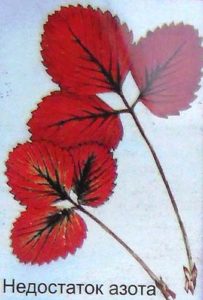
What to do if strawberry leaves turn red due to lack of nitrogen?
Of course, feed nitrogen fertilizers:
- Mineral: urea / urea (10-15 grams per 10 liters of water) or ammonium nitrate (15-20 grams per 10 liters).
Advice! In cool weather (up to +15) it is better to use ammonium nitrate, and in a warmer one (above +15 .. + 20 degrees) - urea / urea (under such conditions, it dissolves better and is absorbed by the plant).
Moreover urea it is desirable to conduct foliar feeding (by leaves)... So she better and faster assimilated strawberries.
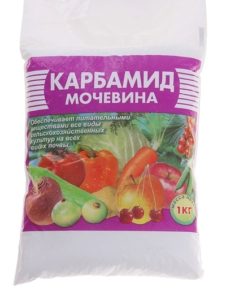
- Organic: green fertilizer (infusion of nettle, dandelion, plantain), cow dung or mullein (if fresh, then about 1 to 15-20, if concentrated, then according to the instructions), bird droppings (fresh 1 to 10-15, if dry, then see instructions).
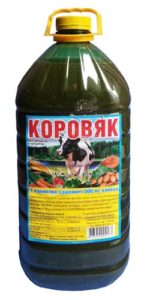
Phosphorus
Strawberry leaves are small (smaller) ..
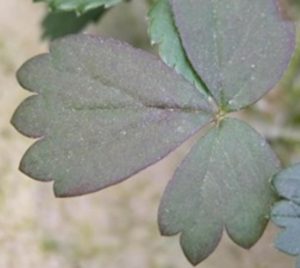
and turn purple - this is a clear sign of a lack of phosphorus.
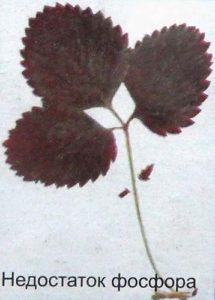
In other words, you need to feed the strawberries with phosphorus fertilizer:
- potassium monophosphate (20-30 grams per 10 liters);
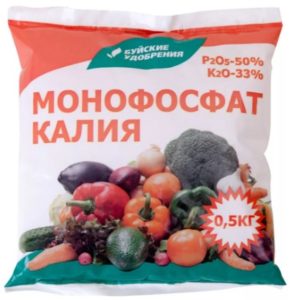
- to cook fast phosphorus feeding from superphosphate (preferably double).
Recipes preparation of an easily digestible phosphate fertilizer from superphosphate detailed in this material.
In general, you can fertilize strawberries and dry phosphorus fertilizers, but the effect will be already next year (since these are not quickly digestible fertilizers), so it is better to do this after harvesting, i.e. in late summer - early autumn.
Immediate application of the appropriate fertilization helps to eliminate visual symptoms of malnutrition, improve plant growth and fruiting, but will never reach the level that plants do not suffer from this degree of malnutrition.
Potassium
In case of a lack of potassium, strawberry leaves turn red at the edges (acquire a red-brown border).
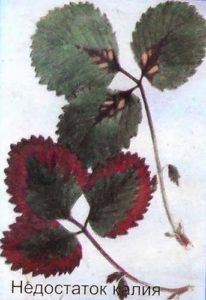
By the way! With a lack of potassium, the berries also become smaller.
What potash fertilizers to feed strawberries if the edges of the leaves are reddened:
- potassium sulfate or potassium sulfate (15-20 grams per 10 liters of water);
Sometimes potassium sulfate also contains some magnesium.
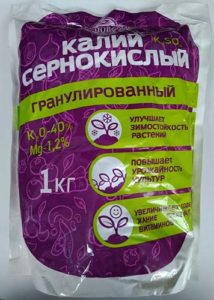
- potassium magnesium (potassium + magnesium);
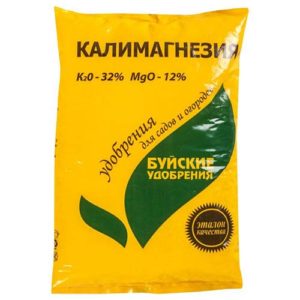
- wood ash (100-200 grams per 10 liters).
By the way! The site has a separate article about how is wood ash useful for plants, when and how to use it in horticulture.
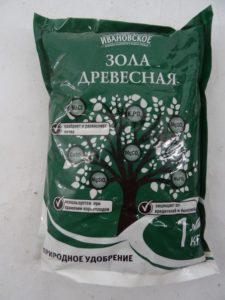
Trace elements (calcium and magnesium)
Also, strawberry leaves can be colored in different ways in red or brown shades in the case of a lack of certain trace elements:
- calcium;
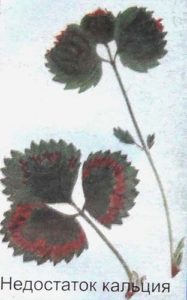
- magnesium;
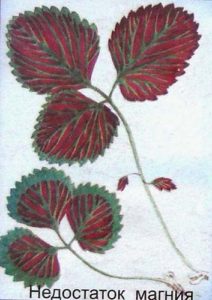
What to do?
Perform a complex feeding with a certain cocktail of trace elements such as Humate +7 or a similar agent, for example, the same potassium magnesium (in which potassium and magnesium), calcium nitrate (nitrogen and calcium).
Natural dying off (reddening) of old foliage in autumn
If strawberry leaves turn red in autumn, then there is no need to worry at all, this is absolutely normal and natural course of withering away of old foliage.
The fact is that along with a decrease in daylight hours, there is a natural destruction of chlorophyll in the leaves,
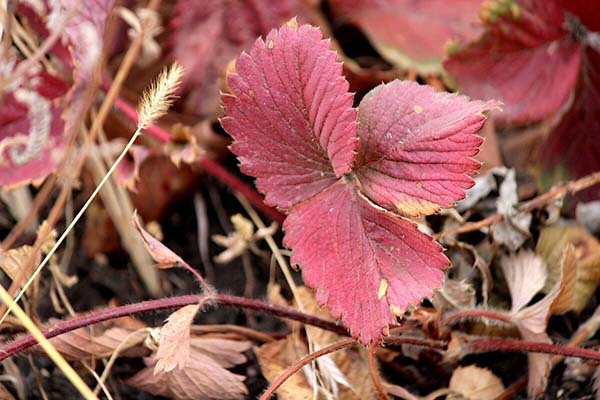
Thus, now you know what are the causes of reddening of strawberry leaves and what to do if red or brown spots appear. Care for your garden strawberries properly and get stable yields. Good luck and delicious berries!
Video: what causes strawberries to turn red, causes of red and yellow spots, what to do and how to treat

